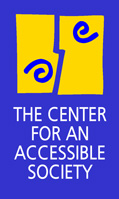
DISABILITY
ISSUES
INFORMATION
FOR
JOURNALISTS
ABOUT
THE CENTER
How is industry doing with access?
Note to readers: links to news articles may not work after a few weeks, as news media remove current stories to their archives. The link may take you to the archives section, where, for a fee, you can view the article.
Apr. 6, 2004 -- Access guidelines for electronic products and for the built environment are having an effect, to be sure. More products, more homes, more buildings are becoming accessible to people with disabilities. But how well are access guidelines actually being followed? A new survey aims to find out what consumers think of the access of a number of new electronic products; a survey last year from HUD found out how well access guidelines were being followed in HUD housing units.
Currently, the Georgia Tech Research Institute wants to know what you, as a person with a disability, think of the accessibility features built into products such as ATMs, cell phones, personal digital assistants (PDAs), on-line training software, distance learning software, voice recognition technologies, and televisions. If you'd like to participate in their survey, go to http://aef.gtri.gatech.edu/universal_design.html to find out more and to sign up.
Last year, a survey found that most HUD buildings do have accessible entrances, on accessible routes and most have common areas that conform to HUD's "Fair Housing Accessibility Guidelines." However, it found that fewer managed to ensure that light switches, electrical outlets, thermostats and such were placed at accessible levels as required by the Guidelines; ;that kitchen and bathroom access was even less compliant with the Guidelines, and that the lowest compliance was with reinforcing walls for grab bars.
The multi-year study by HUD, "Multifamily Building Conformance with the Fair Housing Accessibility Guidelines," was "developed in part because evidence from the field, complaints filed with HUD, and private litigation suggested that some architects, contractors, and building owners were either ignorant of, or were avoiding, the law and were building multifamily projects that did not comply with the Act's design and construction requirements," say researchers in the report. The survey included "a review of site and building plans, on-site inspections of buildings, and tabulations of individual building evaluations." Read the complete 207-page study, "Multifamily Building Conformance with the Fair Housing Accessibility Guidelines".
To receive e-mails about HUD research and resources, subscribe to the HUD User listserv at http://listserv.huduser.org/ -- to subscribe, send an email to hudusernews@huduser.org with "subscribe" in the subject line.